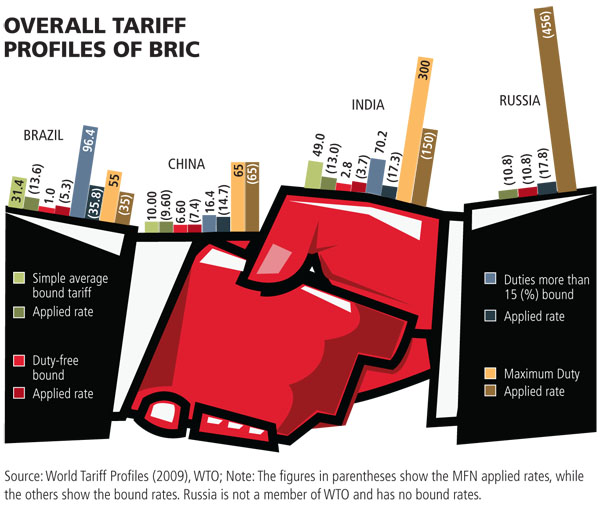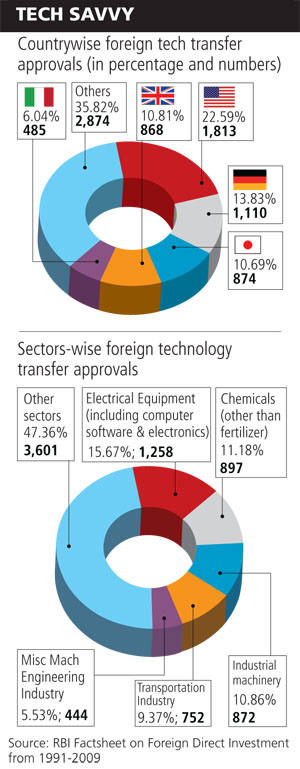
Indian Markets: Open Sesame
In a rather candid conversation last year with Forbes India, Sunil Mittal, chairman, Bharti Enterprises told us, “Now, India is done. Of course, there is still some growth left. I’m not saying it’s all over… but we need to expand our horizons and go out of India.” The context was Mittal’s Bharti Airtel bid for MTN, the largest telecom services provider in Africa. The stock markets perceived this a foolhardy attempt and hammered Airtel’s stock down to its lowest levels in a long, long time.
 Mittal though remained unperturbed and clear on why Airtel had to be in Africa. It is home to a middle class variously estimated at anything between 350 million and 500 million people, as large, if not larger than India’s. If his company intended to sustain the momentum it had gained in India, it needed access to new markets.
Mittal though remained unperturbed and clear on why Airtel had to be in Africa. It is home to a middle class variously estimated at anything between 350 million and 500 million people, as large, if not larger than India’s. If his company intended to sustain the momentum it had gained in India, it needed access to new markets.A few weeks after the interview was published, he aborted the attempt to gain control over MTN, kept low for a few months and finally wrested control of Zain Telecom, the second largest player on the continent, after paying $10.7 billion.
If you ignore what the stock markets think for a moment, then Sunil Mittal is clearly a metaphor for India’s aspirations. What he is attempting for Bharti Airtel represents a microcosm of everything India ought to be attempting, but on a larger canvas. Over the years, he worked hard at innovating and integrating the best practices and technologies available to telecom businesses to build a compelling proposition. And when the time was right, he worked harder at prying open the African market to secure his future.
To that extent, the issues Indian planners now have to deal with over the next decade or so are these: What is it that they can do that will open up for Indians like Sunil Mittal access to new markets? And, what are the kind of tools they ought to arm men like Mittal with that will give them the edge they need to become significant players in the global arena?
There is a larger issue here. To lift close to 500 million people out of poverty, India needs to grow at 10 percent for at least 10 years. Which means, exports that now account for 15 percent of India’s GDP ought to grow at anywhere between 20 and 25 percent.
To meet these targets, India needs to provide its foot soldiers like Sunil Mittal access to new markets in other parts of the world. But gaining access to new markets comes at a price — you open up your markets to others as well. And this isn’t something India is entirely comfortable with yet.
Legacy Baggage
It was only after 1991 that India started to transition into a more outward looking economy. It began to scramble for an increased presence on tables of the kind hosted by bodies like the World Trade Organization (WTO).
Much water has passed under the bridge since then. India is now among the most important decision makers at the WTO and the challenges it faces now are significantly different. As recently as five years ago, Indian negotiators at the Doha Round of the WTO figured the initial negotiating stances they had assumed were now counterproductive to the country’s interests.
For instance, India is now deficient on oil seed production. But barriers exist that prevent imports of oil seed into the country. “It is difficult to understand why oilseed deficient countries restrict import of oilseeds,” says Amitendu Palit of the National University of Singapore in his paper “India’s trade strategy for acquiring greater market access”.
To be fair though, this is a legacy issue. When India got on these tables in the early years, the compulsions to protect agriculture was both economic and political. Over the years though, as the economy morphed into a different animal, negotiators found themselves defending economically unviable positions.
“For us, it is a livelihood issue of some of our poorest citizens,” argues Rahul Khullar, India’s commerce secretary. “We cannot allow the whole groundnut economy of Andhra Pradesh and Gujarat to be wiped out for some economic gains,” retorts Khullar. Be that as it may, sensitivities around allowing agricultural imports have resulted in India being one of the most protected countries among emerging economies. This needs to change, and this is also where the problem lies. It is against this background that pointers on India’s strategy to carve for itself access to new markets are emerging.
Pointer #1: Engage Strategically
Traditionally, India has been a votary of multilateralism. This is because at forums provided by the WTO, the rules of the game stay the same for all negotiating countries, irrespective of their trading clout. To that extent, there is a broad consensus among Indian officials that India’s real hope of gaining market access lies in the WTO route. But the Doha Round of the WTO talks has been deadlocked for a while. To break the deadlock, some rigid positions will have to give, which may take a while.
If positions don’t, chances are WTO sponsored talks could fail. In which case, participating nations need to hedge their bets. That is why many nations, India included, have directed their immediate attention towards concluding as many regional and bilateral agreements as possible.
These agreements have already impacted trade patterns. For instance, between 1991 and 2009, the share of India’s trade with US, Japan, Germany and UK was 35 percent. It is now down to 17 percent. Instead, the significance of other Asian economies, most notably China, has gone up dramatically.
“The idea here,” says Manoj Pant of the Centre for International Trade at Jawaharlal Nehru University “is not market access. Instead, it is to formalise existing trade relations and build a consensus that can be used later at multilateral forums.” There is a downside as well to such treaties though. Pant explains bilateral and regional agreements allow participants the flexibility to have a negative list — essentially, a list of goods that cannot be traded. So member countries can potentially make regional agreements meaningless by keeping key commodities on the negative list.
 Infographic: Sameer Pawar, Hemal Sheth
Infographic: Sameer Pawar, Hemal ShethThat said, the strategic and political gains such agreements bring outweigh the downsides. For instance, when tariff barriers are dismantled at multilateral forums, nations resort to non-tariff barriers (NTB). In the textiles business, to keep Indian exports out, some countries have imposed a ban on the use of a certain type of dye used by Indian manufacturers. Says Rahul Khullar, when it comes to cases like these, regional and bilateral agreements are a more appropriate forum to sort things out.
Pointer #2: Deepen Existing Market Access
One way of doing this is to deepen existing market access in the developed world because of strong complementarities. India has a comparative advantage in traditional and labour intensive products like textiles and leather. Thanks though in large part to selective NTBs, India’s advantages in these areas are slipping. Policy makers believe that going forward the edge will lie in engineering goods, generic pharmaceuticals, and chemicals even as they attempt to negotiate their way around NTBs that have been erected.
The second area which can open new markets for India is through trade to the developing world, especially Africa. Asian exports are predominantly manufacturing-based. While India is weak here, it excels in exports of services like IT, construction and manpower.
“The world is going to reconstruct Africa and somebody has to get into it,” says Pant. “We had a head start over China in Africa because of historical ties with many countries there. But now China has overtaken us because they are the ones who are making the roads, not us,” he adds.
As things stand now, world over, any negotiations around services are preceded by that for trade in goods. But constant deadlocks have meant India hasn’t been able to push its agenda effectively. That, however, is only a matter of time and in the medium- to long-term future, trade in services is likely to provide the biggest impetus to India’s potential.
Pointer #3: Build R&D Capabilities
Let’s go back to the Sunil Mittal analogy for a moment. Do you think it possible Airtel could mount its assault on Africa if it didn’t have the capabilities to build and operate low-cost networks? What if it hadn’t outsourced network management to IBM and Ericsson, the best of breed operators? What if Airtel hadn’t figured technologically viable solutions to drive down the cost of telephony, making it viable for low-income consumers?
Short answer: No.
Long answer: To make the transition from being a fringe player in the telecom business, Sunil Mittal did a couple of things right. He identified the best partners and technology vendors from across the world, used their expertise to build a formidable creature that can service his customers in the country, and is now using all that he’s learnt to access markets abroad.
In some sense, where India finds itself now is where Sunil Mittal found himself when he first got into the telecom business. In the past, technology development in the country was need-based and not driven by any ‘grand national plan’. India, therefore, has remained a buyer of technology, limited by its resources and not a creator of technology.
S. Chandrasekhar of IIM Bangalore who co-authored the paper National Interest and Technology with ISRO’s Y.S. Rajan, technology forecaster B. Bowonder, defence scientist Amitav Mallik and former ambassador Santosh Kumar, says, “If you look at what happened in the US and other industrialised countries over the last 300 years, a lot of it was driven by domestic needs. One way to look at the evolution of their strength and expertise is that they were shaped by domestic compulsions, domestic elements, domestic demands and needs.”
 To do that though, Indian technical capabilities will have to grow at a faster rate as compared to growth rates in more advanced countries.
To do that though, Indian technical capabilities will have to grow at a faster rate as compared to growth rates in more advanced countries. India currently uses a follower strategy, which means innovation happens elsewhere in the world first and India follows. For it to become a dominant player in any industry, it ought to be able to do two things. First, link technology and products to domestic markets and needs. Second, create new technology-driven product and industry life cycles.
Y.S Rajan says, “Japan in the sixties and Korea in the seventies are good examples of how countries can acquire and develop technologies.”
By way of examples, biotechnology (BT) has emerged as a significant force in the developed world. Its applications and businesses are crucial to economic and public good (for health, environment etc). India has begun with a few companies and in a bigger way with educational programmes. But India is yet to begin manufacture of biotech equipment, hardware and tools. Similarly, India has yet to get its act together on GM seeds and herbal technologies which will be crucial for future, high-income agriculture.
Some technologies like functional foods, corona, mathematical modelling of bacteria outputs and micro-encapsulation of chemicals may appear distant now. But these are likely to emerge as big on the radar seven to eight years from now. Many of those technologies will be in a mature and diversified phase by that time. Some new disruptive technologies are also likely to emerge.
In many emerging areas, which will dominate the world economy in about a decade, India lags behind. A mere catch-up is not enough. To be sure, the current phase of economic growth through technology import is essential. Well before the year 2020, there is a need to put together a national innovation system to begin the next phase of leadership in industries and technologies.
Chandrasekhar says, “We did a study on how technology evolves from one generation to another by looking at patents in aerospace turbines. In the US, in six years the turbines were on commercial airplanes. We compared that to China, and found that, even though they had the technology they could not apply it commercially.”
The reason, he explains, is domestic capabilities. The US probably has the best system in the world for innovation. And it is not easily replicable. Higher education is just one piece of it. It is the flexibility the system has in moving people from education to research to industry, the power of social networks, support from the industry and the government.
The government, authors of the report argue, also ought to facilitate Indian companies leverage domestic strengths and look at the global market. Ranbaxy, Dr. Reddys, and other pharma companies, Bharat Forge, Asian Paints and even Arvind Eye Hospitals illustrate some success stories. External policy should support and facilitate such moves, not only by big companies but also by small and medium enterprises.
The global market is not built up just by pure market forces. There are various forms of privileged access as well as targeted denials. Diplomacy has a crucial role to play in solving problems and enabling access to identified technologies on a privileged or commercial basis.
Chandrasekhar adds a word of caution as well: “Whenever government plays a facilitating role, there is always a danger the agenda can be hijacked. You need some kind of checks and balances. I am not convinced these exist today. When I look at mining industry, I think it’s done disgracefully. I am not a great advocate of what industry does, but maybe it’s better than what the government does. May be if we can have some kind of agreement between them, it will be the right thing to do. The question is whether it’s going to happen or not.”
(This story appears in the 27 August, 2010 issue of Forbes India. To visit our Archives, click here.)
Post Your Comment















